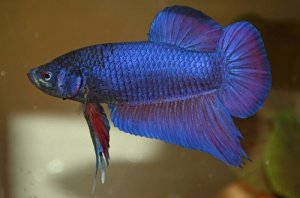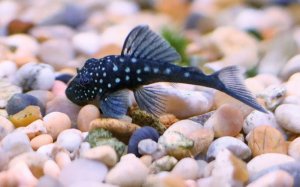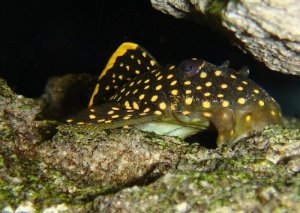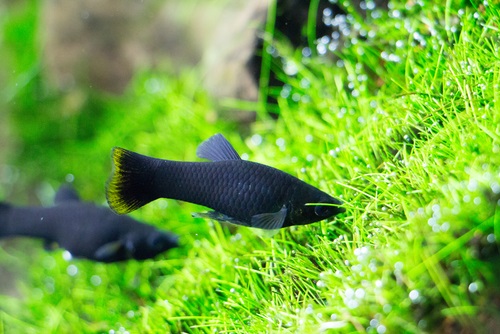
The Black Molly is a direct descendant of the Original Sailfin Molly found in Mexico and Central America. It is a solid Black color Molly that may have different tail variations, and light patches on the skin, depending on the individual fish.
Mollies, in general, are peaceful and highly adaptable fish that can easily live in freshwater and saltwater. The Black molly is adored for its brilliant black color and it is known to be an inexhaustible breeder that will soon have your tank filled with tiny fry. The Black Molly in temperament is something to experience, being peaceful, but not shy at all.
Overall, I would like to warrant you the best care tips, if the Black Molly is a freshwater fish species that has captured your liking.
Breed Overview
| Origin | South America and Mexico. |
| Lifespan | 3-4 years in Captivity. |
| Size | Standard sizes; Males 3.2″ (8 cm), Females 4.8″ (12 cm). |
| Colors | Black, White, Green, red, orange, yellow, Gold, Marble, Dalmatian, Leopard. |
| Food | Omnivorous |
| Tank Size | 20 – 45 Gallons. |
| Temperament | Bold, Peaceful, Males are Aggressive on their own. |
| Water Temperature | 75-80°F (24-27°C). |
| Water pH | 5 – 8.5. |
| Difficulty Level | Beginner |
Species Summary
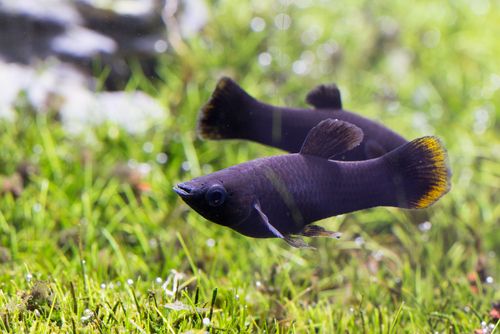
The Black Molly (Poecilia sphenops), is represented as a freshwater fish, though its natural habitat consists of freshwater streams, and coastal marine and brackish water streams and pools. The Black Colored Molly specifically is a hybrid from the short-finned variation of Sailfin Molly.
Thus, the black Molly will have short fins but be completely black rather than dull silver, in color. Originally from South America, the black Molly can naturally be found in waters from Mexico to Columbia, and it is one of the most popular Molly species from both Freshwater and Marine aquariums today.
Color Variations
The Black Molly has a body shape similar to that of the Swordtail Molly, with an oblong shape, a small head, a flattened dorsal, and an upturned mouth. The Black Molly will be entirely black, with some species having slight dull silver patches on their bodies.
With more selective breeding throughout the years, more and more color variations and body shapes have been bred in the Molly fish:
Tail And Body Shapes
The Most common type is the shortfin molly originating from the Sailfin breed, The Lyretail Molly has a slightly altered Caudal Fin Structure., and the Yucatan or large Sailfin Molly features a large dorsal fin resembling a sail.
Short Fin
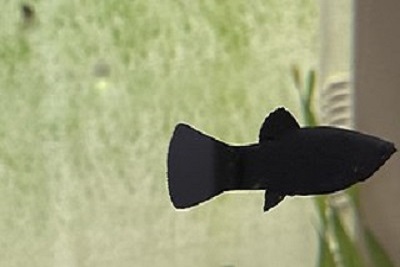
Lyretail
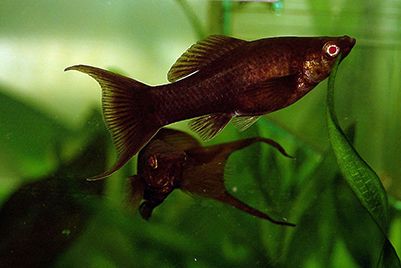
Yucatan
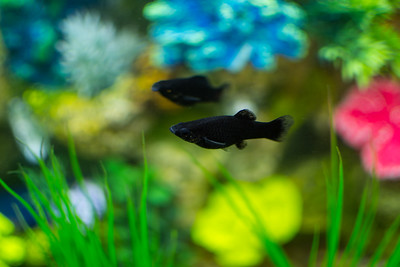
Molly Color Variations
Besides the solid black molly, there is also the solid White Molly, Golden Molly, Yellow, Green, Red, Orange, and Dalmatian Molly which is silver with black speckles. Similarly, there are the Leopard variation, and Marbled variations available in most colors.
Difference Between Male And Female Black Mollies
Distinguishing between a male and female Molly is relatively simple;
- Males – Males have a Torpedo shape, larger fins, pointed gonopodia (Sex Organ in Fish), and modified anal fins for mating.
- Females – Females are more bulky and wider in shape, with shorter fins and a triangular-shaped anal fin.
Size And Lifespan Of The Black Molly
The standard size of an adult male Molly will be around 3.2 inches, or 8 cm, whereas the females are larger at 4.8 inches, or 12 cm., with the maximum recorded size for the species being 15 cm, 5.9 inches.
Mollies have an average lifespan of between 3 and 4 years and are avid breeders that may produce thousands of offspring.
Temperament And Behaviour
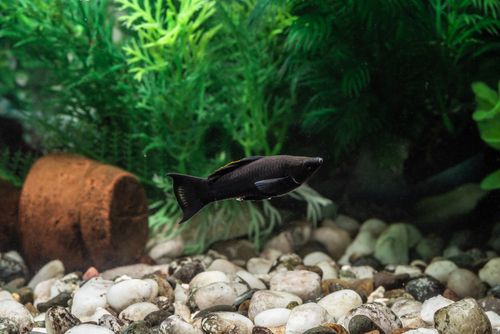
Mollies are relatively peaceful Shoaling fish that need to be kept in small groups. I have heard complaints about males tending to be slightly aggressive, but this is usually when they want to mate with a female.
According to research males with larger dorsal fins will dominate the tank, and this is similarly a very attractive feature to females.
Experts will highly recommend that you always have a one-male-to-three-female ratio in your tank, as too many males may squabble, and harass females.
General Care Of Black Molly Fish
Mollies are very hardy, and adaptable fish that are flexible with most conditions, though certain conditions and feeding routines will ensure a healthier, more lively, and colorful fish. They are perfect for beginners, and the Black Molly is quite a popular favorite in this species. So, let us start with creating the perfect home for your Molly fish:
Creating Your Aquarium
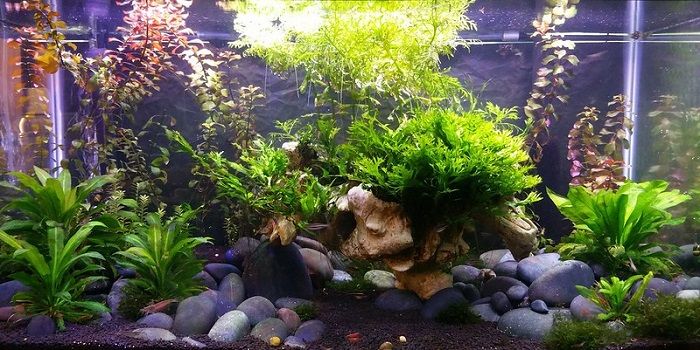
As you may have read, Mollies in general have a natural habitat of shallow waters in ponds, lowland streams, swamps, and estuaries in freshwater and coastal areas. They are a very tolerant species, that can even use the small film of oxygen on the surface of water, should their oxygen levels be depleted. Though in our tank set-up, we want to create the most favorable conditions for our mollies, that slightly mimic their natural habitat.
- Tank Size – The absolute minimum size for a group of four mollies is a 15-gallon (57 liter) tank, though depending on how many Mollies, and other tank mates you are planning to keep, I would rather advise a 20 to 45-gallon (75.7 – 170) liter tank. Mollies are active and enjoy space to swim and move around.
- Water Conditions – Mollys thrive in hard water conditions with a higher alkaline pH of 7.5 – 8.5, and they also appreciate some salt in their water. Water Hardness of (dH) 20.0 – 35.0 is suitable. They are not at all suited for soft water, and comparably enjoy slightly brackish waters.
- Temperatures – Ideally to keep your mollies happy and healthy water temperatures of 75-80°F (24-27°C) should be kept, though they are quite adaptable and can survive in temperatures between 18 -28 °C (64.4-82.4°F)
- Filtration – As we have gathered from their preferred natural environment, Mollies do not like strong currents and would do even better with no current at all, but they still need clean water. Thus, I would advise a Filter such as a hang-on back or sponge filter with a slow current, or adjustable current.
- Heater – An important fact when it comes to heating, Mollies and generally other freshwater fish that can tolerate colder water, do however not thrive in it, they become stressed and much more prone to parasites and disease. So, I would highly urge you to rather invest in a submersible heater and keep within the recommended temperatures of 75-80°F (24-27°C). If you stay in a tropical environment within these temperatures a heater is not necessary.
- Light – Mollies sleep at night and need to have a day and night-time schedule. You can place them in indirect sunlight, or use an LED light during the day.
Tank Décor
Tank décor is your personal preference, and is necessary to create an entertaining, safe, and calm environment for your fish. I usually recommend keeping it closest to its natural habitat, however, the choice is yours.
- Substrate – If you are planning on having Live plants, then sand is your best option and substrates are best if you want plants. Aragonite sand is ideal as it disperses beneficial minerals and serves as an anchor for plants.
- Ornaments – Because Mollies enjoy having some form of shelter, I would recommend ornaments such as caves, Clay Pots, Driftwood, Rocks, and even castles or shipwrecks that are large enough.
- Synthetic Plants – If you want to opt for synthetic plants, choose plants with soft silk or fabric leaves that will not cause injury to your delicate fish.
- Live Plants – For me, Live plants are always a better, more natural choice. Live plants can provide oxygen in the water and help to clean the tank. They can also be something for fish to snack on. Mollies enjoy lush vegetation on the sides and edges of their tank, with open spaces for swimming in the center.
These are some ideal plant choices that you can consider;
- Rooted Plants – Anacharis, Myriophyllum, Vallisneria, Bacopa, Java Ferns, Amazon Sword, Red Ludwigia, Cryptocoryne wendtii.
- Carpet Plants – Water Wisteria, Java Moss, Dwarf Hairgrass, Glossostigma Elatinoides.
- Floating – Hornwort, Moneywort, Water Lettuce, Water Sprites.
Adding Molly Fish To Your Aquarium
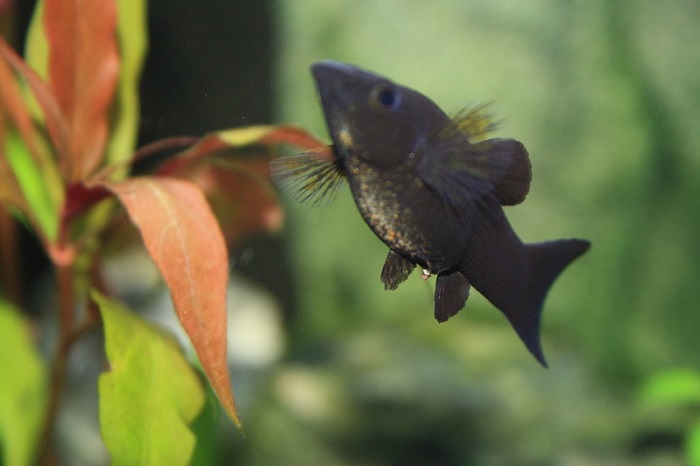
So, by now you have completely set up your tank and hopefully allowed the water to cycle for a few days, to a week. You will need a testing kit and thermometer to ensure all the water parameters are in top condition. At this stage you can purchase your new Mollies from a reputable breeder, or trusted pet store, keeping to the ratio of three females per male. However, let’s first look at some signs of healthy fish:
Choosing A Healthy Black Molly
First of all, check the coloration and shape of the body of the fish. There should be no scales sticking out, very rounded bellies, pale-colored or eyes bulging, and the fins must not hang. Also, check that there are no patches or white spots on the skin, that may indicate parasites.
Likewise, look at the behavior of the fish, they should be active and lively, swimming around, and eager to eat when presented with a snack.
Adding Fish To Tank
You should always follow these steps before placing any fish in a new or communal tank;
- Float the bag with the fish in the tank for around 20 minutes.
- Replace the water in the bag with water from the tank cup by the cup at intervals of 15 minutes.
- Allow your fish to swim into the tank, or use a net, being careful not to allow the water from the bag inside the tank.
- Keep a close eye on your fish for a day or two to ensure they are healthy and calm.
A Few Quick Tips;
- Always quarantine new fish and plants first to prevent the spread of diseases and parasites.
- In a communal tank, ensure all the other fish are fed, and rearrange a few items in the tank before adding new fish.
- Ensure that your tank is properly cycled before adding fish to a new tank, this should take at least two to three days.
Selecting Tank Mates / Companions
Besides, just your Mollies you may want the company of a few other tank mates. Yet, before we get into that, keep in mind though they are peaceful shoaling fish, Mollies are dependent and boisterous, so they will stand their ground. They will not do well with aggressive fish species, or fish much smaller than them, they similarly tend to eat shrimps in their tank.
Mollies are live-bearing fish similar to guppies, and cannibalistic, thus they will feed on their young fry, and that of other fish in the tank.
- Bottom Feeders – I always recommend a good bottom feeder, or algae-eating fish to help clean your tank, and add some companionship. You can choose from; Kuhli Loaches, Otocinclus Catfish, Siamese Algae eaters, and Bristlenose Plecos.
- Smaller Shoaling Fish – Smaller Shoaling fish that are fast and active is ideal in groups; Danios, Tetras, Rasboras, White Cloud Minnows, and Guppies.
- Similar Sized Fish – Similar in size such as the Platy and Dwarf Gourami.
- Snails – Snails similarly clean your tank, though they can quickly reproduce, and produce quite a bit of waste. Nerite Snails are ideal because they are smaller and will only reproduce in saltwater.
Feeding
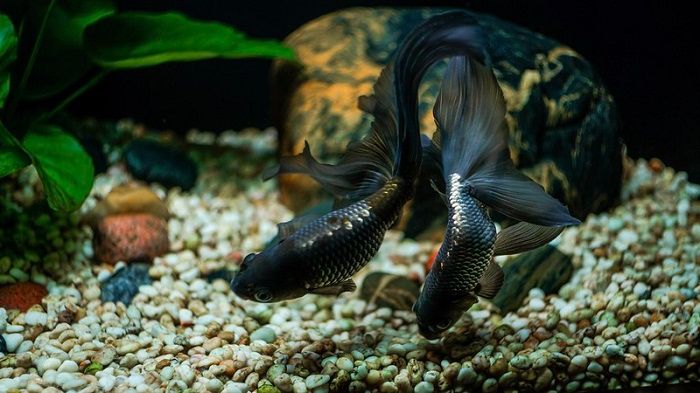
In their natural habitat the Sailfin Molly, or Black Molly mainly feeds on Algae and plants, though they occasionally enjoy aquatic invertebrates and insect larvae such as mosquito larvae. They are omnivores, that are top feeders, however, will take food at any level of the
What To Feed
Mollies need a varied diet with quality fish food, meat-based, and plant-based foods.
- Pellets And Flakes – As a staple diet Mollies require a quality and balanced flake or pellet food. A highly recommended food for them is Micro Wafers, which is a slow-sinking food that is in a disc shape with high protein content.
- Live And Frozen Foods – You can feed your molly Live and frozen foods such as Brine Shrimp, Daphnia, Micro Worms Tubifex worms, Blood Worms, and even Vinegar eels.
- Human Foods – Rather an interesting fact, Mollies can be fed human foods of plant and meat matter. Meats include boiled shredded chicken, boiled egg yolk, and cooked and shredded Beef heart. Vegetables need to be blanched or steamed and cooled first and you can feed them spinach, Cucumber, Broccoli, Green Beans, Lettuce, Zucchini, and Carrots.
- Plant Material – Some of the Live plants included in our list also serve as a source of food for Mollies, Mollies are relatively fond of algae in general.
How To Feed
One thing that I love about Mollies is that they spit up their food when they have had enough. So, you can feed them once or twice a day, ensuring that all food is in small enough pieces to prevent choking, and they will finish their meals within five minutes or less.
Tank Maintenance
You need to remember that fish, other tank mates, plants, and even leftover food quickly create a mess in your tank and can lead to very dangerous ammonia. Thus, it is good practice to do a weekly water change of your tank water of at least 25% of the water. You can follow these step-by-step instructions.
Similarly, ensure that you remove any old food, dead plant matter, and debris and that you clean ornaments and tank equipment that has become soiled.
Common Pests And Diseases
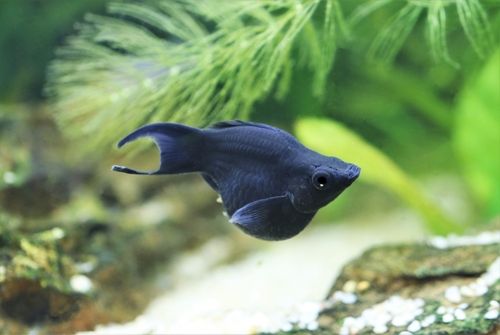
Even with your best efforts fish may get sick, or pick up a parasite or two for reasons unclear. Though, if you keep your aquarium clean, feed your fish a balanced diet, and keep water temperatures and parameters at the right levels, you should not encounter any issues.
As advised, make sure that any new plants, fish, ornaments, or habitants added to your tank are completely healthy and clean.
Other than that here are a few common health issues that may affect your Mollies;
- Parasites – Trematode is a well-known parasite found in Black Mollies that causes white spots, or Ich as we know it. The condition can be treated by quarantining your fish in water with higher temperatures and using antibacterial medication.
- Swim Bladder / Dropsy– The Swim Bladder of your fish is an organ that helps the fish to stay afloat. When you notice your fish struggling to stay upright or swim, there may be damage to or an infection in the swim bladder. Isolating your fish in clean water, and treating it with antibiotics is the best course of treatment.
- Fin Rot – Poor Tank Conditions, Ammonia burns, and physical damage may cause Fin Rot which is a bacterial infection that causes streaks and patches on the fins, as well as a ragged appearance. Fin rot is treated by isolating the fish in clean water and using an antibacterial medication.
How To Breed Black Mollies
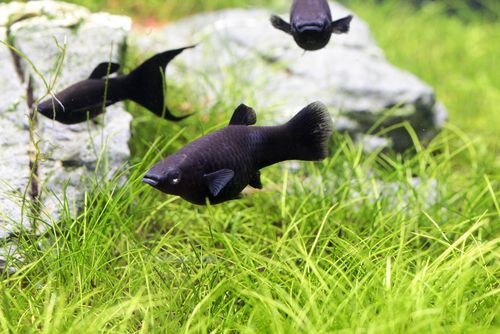
Breeding Mollies is straightforward, and they will breed by themselves in a community tank where there are males and females, though they tend to eat their young, so a proper breeding tank is advised should you want to breed.
Mollies are live-bearing fish with the female being able to produce over 100 fry at a time, and they can store sperm, months after mating has taken place.
Females usually choose males with the largest fins and brightest colors to mate with. After mating, females need to be placed in a separate tank for the gestation period which is between 30 to 40 days. They will give live birth to between 20 and 100 small fries, however, they do not provide any parenting and must be removed from the breeding tank after birthing.
If you feel that breeding mollies is something you would like to pursue, I highly recommend reading Breeding Mollies in Wikipedia for more in-depth information.
Final Thoughts
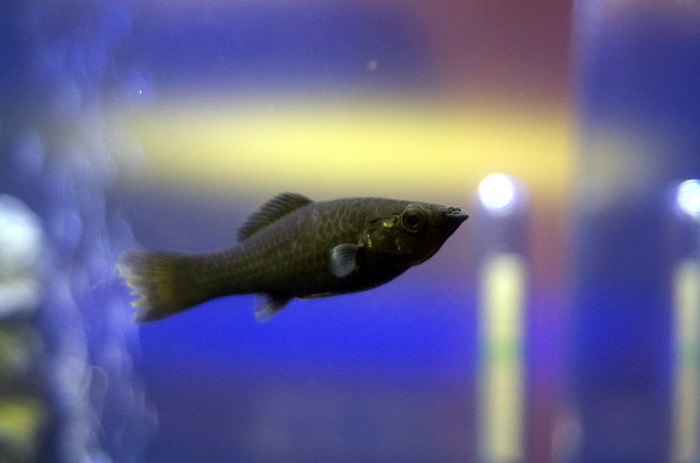
Lastly, as you can see Mollies are hardy and interesting fish that are easy for beginners, and that come in some exotic colors and markings for collectors and experienced Aquarists that may like to breed with them. They rarely have any issues in terms of health, and are very tolerant to most water conditions, making them a popular choice as a pet.


